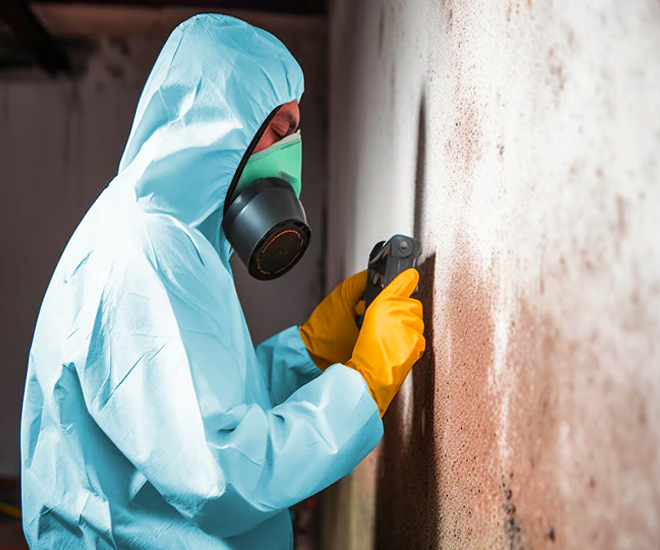Testing Air Quality After Mold Remediation
Testing Air Quality After Mold Remediation
Blog Article
Specialist Tips for Blog Post Mold Removal Success
In the realm of mold removal, effectively getting rid of mold is only half the battle; real difficulty exists in stopping its reappearance. Post-remediation efforts play a vital duty in making certain a mold-free environment in the long term. By adhering to professional ideas and best methods, people can protect their areas against mold revival and preserve a healthy indoor atmosphere. It is in this phase of the remediation process that attention to information and proactive measures truly make a difference.
Screen Humidity Degrees On A Regular Basis
After finishing mold and mildew remediation procedures, keeping ideal moisture degrees is critical to avoid mold and mildew re-growth and ensure a healthy interior environment. High humidity levels over 60% create a favorable setting for mold to grow, making regular keeping an eye on a positive measure to stop any kind of future mold and mildew problems.
In addition, developing a routine timetable for humidity checks, especially in risky locations such as kitchen areas, bathrooms, and cellars, is a positive approach to mold avoidance. By constantly keeping track of humidity degrees, residential property owners can properly reduce the threat of mold reoccurrence and keep a healthy indoor setting post-remediation.
Conduct Thorough Inspections Post-Remediation
Complying with the conclusion of mold remediation treatments, it is crucial to conduct detailed inspections to confirm the effectiveness of the remediation procedure. These post-remediation inspections are vital in ensuring that the mold problem has actually been successfully dealt with which there is no reappearance or remaining mold development. Examinations should be executed by certified specialists that have proficiency in determining mold and mildew and analyzing interior air quality.
During these evaluations, different approaches such as aesthetic analyses, air tasting, and surface area tasting might be employed to completely examine the remediated areas. Aesthetic assessments involve a comprehensive assessment of the facilities to look for any type of noticeable indicators of mold and mildew development or water damages. Air tasting aids in establishing the air-borne mold and mildew spore levels, while surface sampling can spot mold particles on surfaces.
Implement Correct Air Flow Methods
After ensuring the efficiency of the mold and mildew remediation procedure through thorough assessments, the next important step is to concentrate on implementing appropriate air flow techniques. Ample ventilation is crucial in avoiding mold and mildew reoccurrence by controlling wetness degrees and advertising air circulation.
Appropriate air flow not only aids in avoiding mold growth but also contributes to the overall health and comfort of occupants. By guaranteeing sufficient ventilation throughout the home, you can decrease the risk of mold regrowth and develop a much healthier living atmosphere.

Usage Mold-Resistant Materials for Repairs
To boost the lasting efficiency of mold removal efforts, including mold-resistant products for repair work is crucial in mitigating the threat of future mold development. Mold-resistant materials are designed to hold up against wetness and inhibit mold and mildew growth, making them a crucial option for areas susceptible to dampness and humidity. When fixing locations influenced by mold and mildew, using products such as mold-resistant drywall, mold-resistant paints, and mold-resistant caulking can assist protect against mold and mildew recurrence.
Mold-resistant drywall is an exceptional alternative to standard drywall in areas like restrooms and basements where moisture levels are greater. When exposed to damp conditions, this type of drywall has a special finishing that stands up to you can look here mold growth even. Furthermore, making use of mold-resistant paints having antimicrobial agents can even more inhibit mold advancement on wall surfaces and ceilings.
In locations where dampness prevails, such as bathrooms and kitchens, utilizing mold-resistant caulking around sinks, tubs, and windows can help seal out water and prevent mold from holding in splits and crevices. By purchasing these mold-resistant products during repair work post-remediation, you can significantly reduce the likelihood of future mold problems and preserve a healthier interior atmosphere.
Maintain Sanitation and Address Water Issues
After mold and mildew remediation, it is critical to preserve a tidy environment to prevent the regrowth of mold. Leakages, water invasion, or high humidity levels can develop the perfect breeding ground for mold and mildew, so it is vital to take care of any water-related issues immediately.
To keep cleanliness, think about utilizing HEPA filters in vacuum cleaners and air purifiers to catch mold spores and prevent their flow in the air. Making sure correct air flow in areas susceptible to moisture buildup, such as kitchens and bathrooms, can help maintain moisture levels in check. By staying vigilant about sanitation and resolving water concerns immediately, you can efficiently avoid mold and mildew reinfestation and keep a healthy and balanced indoor environment.
Verdict

In the realm of mold remediation, effectively getting rid of mold and mildew is my explanation only half the battle; the true difficulty exists in stopping its reappearance. After finishing mold and mildew remediation treatments, keeping optimum moisture degrees is essential to stop mold and mildew re-growth and make sure a healthy and balanced interior setting. High moisture degrees over 60% develop a helpful setting for mold and mildew to grow, making normal checking an aggressive measure to avoid any future mold issues.
To enhance the long-term visit the site effectiveness of mold removal initiatives, including mold-resistant products for repair services is vital in alleviating the danger of future mold growth. After mold and mildew removal, it is vital to preserve a clean environment to prevent the regrowth of mold.
Report this page